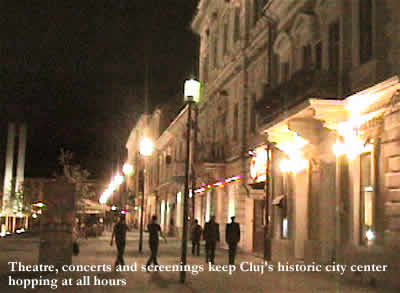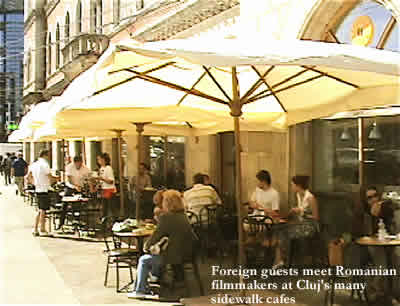CLUJ, Romania – Last year, filmmakers from this often-overlooked country conquered Cannes with a double whammy: the Palm d’Or for Cristian Mungiu’s abortion drama 4 Months, 3 Weeks and 2 Days, along with the top prize in the sidebar Un Certain for California Dreamin’ (Endless) by 27-year-old Cristian Nemescu. (Unfortunately, the director never lived to enjoy his first feature’s success; he was killed in a car crash during post production.) Two years before that, the Un Certain Regard prize was bestowed upon Cristi Puiu’s extraordinary black comedy, The Death of Mr. Lazarescu.
Not since Vlad the Impaler shish-kabobbed his enemies on stakes in the town square, and Bram Stoker stoked the myth of Dracula, has so much international attention been lavished on Transylvania.
Critics and film lovers have cheered Romania’s triumvirate of film triumphs as evidence of a “Romanian renaissance,” a new wave of young filmmaking talent breaking onto the shores of festivals and markets worldwide. Alas, the wave never flooded the cinemas, where box office figures for nearly all of these films has been pretty soggy, although Mungiu’s 4-3-2 has earned a modest but respectable $10 million to date worldwide. Such underwhelming figures are thanks partly to the thankless challenge of marketing lengthy films in obscure foreign languages.
Which begs the question: Is Romania’s renaissance just the product of a lucky couple of years — the equivalent of a budding starlet’s promising debut? Or is there enough filmmaking momentum to power a long and steady run toward  cinematic stardom?
cinematic stardom?
To check it all out, I trekked over to the ancient city of Cluj, nestled in storybook Transylvania in northern Romania, for a visit to the aptly named Transylvania International Film Festival (TIFF) last summer. I wanted to see for myself how the country’s film community had followed up, or not, on its initial global splash.
For starters, Bram Stoker fans would be disappointed, since this sophisticated and scholarly town (there are no less than four universities here) is hardly a haven for vampires, unless you consider 45,000 festival goers feeding off the blood of 200 films from 40 countries a gothic feast.
The only howling over spilled blood in this town was heard opening night at the screening of Michael Haneke’s thriller Funny Games US starring Naomi Watts, Tim Roth and Michael Pitt, about two murderous teenagers taking a suburban family hostage. The film is an American follow-up to Haneke’s 1997 Austrian Funny Games. There were the expected complaints about the festival programmer’s “bizarre” – dare we say gothic? – sense of adventurism in their choice of openers, but  then no one could ever accuse this film forum of being morbidly conventional. (I for one found Funny Games US tedious and narratively weak. Nor did I buy the coy gimmick of the murderer addressing the camera.)
then no one could ever accuse this film forum of being morbidly conventional. (I for one found Funny Games US tedious and narratively weak. Nor did I buy the coy gimmick of the murderer addressing the camera.)
Other festivals may favor de-fanged commercial fare, but Transylvania’s menu this year showed the bite of Romanian cinema’s non-traditional narrative forms in at least a few films. Elevator, an ultra low-budget drama shot entirely in a warehouse elevator where two teens are trapped, took home the award for best debut film for young director George Dorobantu. For all its technical shortcomings it proved provocative enough to fire up some of the festival’s biggest buzz. Alas, it’s easy to envision the film spawning a splashy, overwrought American remake via New Line or Dimension Films — the kind of cinematic rebirth you’d prefer not to see.
Radu Muntean’s Boogie also generated positive word of mouth from the Euro cineaste quarters. It’s a likeable, realist portrait of a day and evening in the life of a married couple that features the long single takes characteristic of the Romanian new wave, along with a well-tuned cast. (In sensibility and technique, the film reminds you of those long chatty takes in Eric Rohmer and Richard Linklater films.) But its quotidian, slice-of-life storyline never manages to cut into the darker sensibilities and dramatic possibilities of its central relationships, and so it fails to deliver on the promise of its oddly ominous and intriguing opening beach scenes.
There was also more conventional fare, such as the wildly popular (with the Romanian public, at least) Silent Wedding (Nunta Muta) from Horatiu Malaele, which earned a five-minute standing ovation at its screening in the jewel box National Theatre here. The film, set in 1953 Romania, boasts a clever conceit: a village’s preparations for a fancy marriage celebration are spoiled when the local authorities mandate an 8-day mourning period for the death of Stalin, which the village slyly tip-toes around by conducting the entire marriage feast in silence (even the village band’s playing is mimed). As shticky and shamelessly theatrical as it occasionally gets, the broad humor of these loopy village characters just might  marry this comedy to a wide and appreciative audience. Judging from the festival response, it’s a guaranteed hit in the old country. But its chances of snagging U.S. distribution seem pretty divorced from reality.
marry this comedy to a wide and appreciative audience. Judging from the festival response, it’s a guaranteed hit in the old country. But its chances of snagging U.S. distribution seem pretty divorced from reality.
So what’s the takeaway on TIFF? After six days of films, seminars, and café-klatch discussions that amounted to a crash course in Romanian cinema (accompanied by plenty of palinca, a fiery Transylvanian brandy with a sting as sharp as Dracula’s), Romania’s new cinema seems a mixed bag. Yes, there are a few directors whose new films break some fresh ground and whose names I’ve jotted down for future tracking (Dorobantu’s among them). There were also a number of films, screened in the strong sidebar “Romanian Days,” which proved once again that this cinema’s greatest strength lies in its ensemble casting – there were plenty of wonderfully authentic performances on display.
On the downside – and it’s an obvious one — there’s the tendency for local filmmakers to indulge in overly long and talky scenes that frequently don’t serve their stories’ best interests, no matter how likeable the cast. Watching them, I felt like I’d been chowing down at a lovely village picnic, only to be interrupted by the inevitable babushka trying to shoehorn herself into my space on the picnic bench. You just want her to waddle off so you can enjoy the damn meal. For these films, a diet of more aggressive story editing is recommended.
 If there were no great revelations at this year’s TIFF, no new 4-3-2’s or bolt-from-the-blue wunderkinds, there’s no reason to be missing them, either. Why should any struggling cinema bear the burden of such expectations? Romania may have won the Palme d’Or once, but who’s to say it may not need to wait another decade or so before lightening strikes twice? France found that out at this year Cannes, when it took home the festival’s top prize for the first time since 1987.
If there were no great revelations at this year’s TIFF, no new 4-3-2’s or bolt-from-the-blue wunderkinds, there’s no reason to be missing them, either. Why should any struggling cinema bear the burden of such expectations? Romania may have won the Palme d’Or once, but who’s to say it may not need to wait another decade or so before lightening strikes twice? France found that out at this year Cannes, when it took home the festival’s top prize for the first time since 1987.
“In Romania, we make very excellent and very bad movies – we don’t seem to make many in between,” said one Romanian film professional at a seminar here (a fellow whose name I carelessly neglected to jot down.) “It’s a paradox, because now our challenge is to work hard simply to make average productions.”
In other words, bigger audiences may follow when moviegoers see more well-made films with more compellingly-told stories, and not necessarily masterpieces. That’s a fair goal for an ambitious but commercially challenged cinema. In a place where the shadow of Dracula haunts almost anyone’s first impressions, it’s a good way to shed light on the real stories behind this rich and imaginative storybook land.
Next week, the heads of the Transylvanian International Film Festival discuss the history and politics of Romania’s New Wave.

